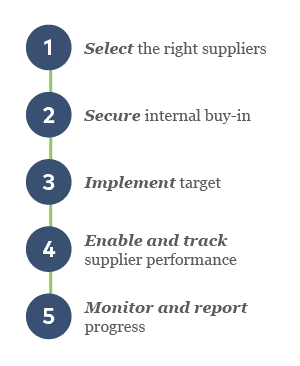An increasing number of companies are setting science-based targets using criteria set out in the Science-Based Targets initiative’s (SBTi) Net-Zero Corporate Standard. One criterion is that companies must set near-term targets on their path to net zero – and if scope 3 emissions make up 40% or more of a company’s total footprint, a near-term scope 3 target must be included.
Companies that set near-term targets for their scope 3 emissions have a choice of two methods:
- Emissions reduction
- Supplier (or customer) engagement target
As of today, less than 20% of companies with near-term targets have used the supplier engagement method. SBTi recently published detailed guidance about how to set a supplier engagement scope 3 target (“The Guide”), which is the first of its kind! This makes it more accessible – and perhaps more appealing – than ever to set a goal of this kind.
Supplier engagement targets may be particularly valuable for a company that:
- Has yet to identify levers for more specific reduction opportunities amongst its value chain partners, and/or
- Does not spend enough on individual suppliers to support collaborative reduction efforts
Most companies that have set a supplier engagement target to date have done so because they recognize that they cannot achieve their climate goals alone.
Supplier engagement targets in a nutshell
The supplier engagement method calls for the reporting company to reduce their scope 3 emissions by influencing companies within their value chain to set a science-based target. The previous guidance for setting a supplier engagement target was fairly limited:
- Supplier engagement can only be used for a near-term target
- It must be achieved within 5 years
- Supplier targets must be in line with SBTi criteria
Now that more detailed guidance has been released, companies have a wealth of additional best practices, recommendations, and examples to consider when designing and implementing their supplier engagement strategy.
The Guide does not mandate new provisions—it’s less about what one “must” do and more about what one “should consider” doing. It proposes that setting a supplier engagement target is a 5-step process.
Step 1: Select the right suppliers
Identify scope 3 categories to include in the target
After completing a scope 3 inventory and identifying hot spots, companies should:
- Prioritize scope 3 categories for inclusion in the target
- Choose supplier activities with which the company has credible engagement
The target should state what percentage of emissions from relevant categories (or, in the absence of emissions data, percent of annual spend) is covered by the engagement target.


Identify individual suppliers to include in the target
Once the relevant scope 3 categories have been identified, companies should then work on supplier selection by:
- Ranking suppliers according to their share of total emissions (or annual spend)
- Selecting suppliers that cumulatively achieve desired scope 3 emissions coverage
- Considering additional factors that may be relevant to supplier selection, e.g. the amount of leverage the company has, supplier’s greenhouse gas (GHG) program maturity, likelihood of the supplier setting an SBT, and whether the amount of business with the supplier is expected to grow
Once suppliers have been selected, they must set targets aligned with the current SBTi criteria. Validation by SBTi is recommended but not required. However, without validation, the onus is on the company to ensure they can count supplier SBTs towards their target, which would be practically challenging for most companies.

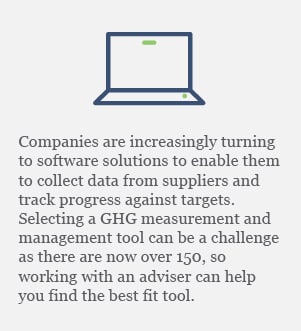
Step 2: Secure internal buy-in
The Guide makes it clear that proceeding with a supplier engagement target should be a cross-functional decision. It provides an overview of the various stakeholders, their roles in the supplier engagement target process, their priorities, and tips on how to frame the initiative.

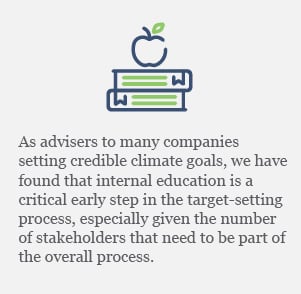
Be prepared to get to know your organization – this will take a village!
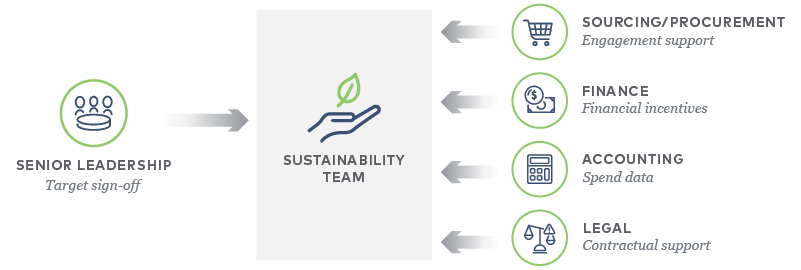
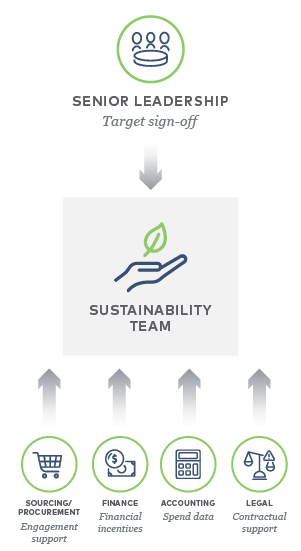
Step 3: Implement target
In order to successfully implement your target, it is critical to define team roles/responsibilities and expectations of suppliers, establish supplier communications, and select data collection and measurement tools. The Guide also suggests:
- When reaching out to suppliers about setting an SBT, the message should come from a senior leader to demonstrate the company’s commitment and help to manage expectations, i.e. whether an SBT a “requirement”, “expectation”, or is merely “encouraged”
- Choosing a data collection solution that minimizes the number of requests placed on suppliers and advocates with a standard questionnaire (while SBTi does acknowledge that standardization may come at the cost of perfectly meeting the company’s needs)
- Putting appropriate controls in place to address suppliers’ concerns over confidentiality


Step 4: Enable and track supplier performance
In order to educate suppliers on measurement and reporting as well as track their performance, the Guide outlines some best practices:
- Make training accessible and actionable
- Consider collaborating with peers to deliver joint training
- Encourage suppliers to conduct scope 3 screens immediately (addressing scope 3 emissions will ultimately be required to achieve long-term targets)
Companies must also consider the types of incentives or support they are willing to provide to suppliers to motivate and reward them.

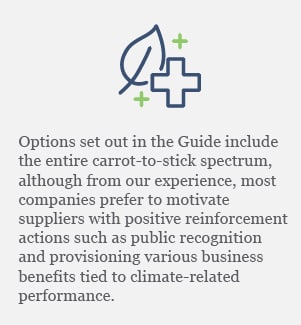
Step 5: Monitor and report progress
Finally, companies need to decide how to monitor suppliers’ progress as they themselves need to periodically report to SBTi on the overall progress made. The Guide offers the following suggestions:
- A central tracking tool that includes a full list of suppliers that are in scope, any relevant categorization or identification information, and their current SBT status
- An annually refreshed scope 3 inventory and related supplier data over the target timeframe, to account for the fact that the supplier list is likely to fluctuate
- Creating best practices for managing annual changes to the supplier list, e.g. inviting new suppliers to set SBTs each year if they enter the target threshold

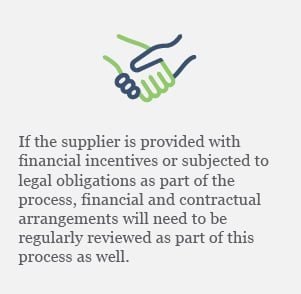
What this means for companies that set supplier engagement targets
The amount of effort and internal resources required to implement this target successfully should not be underestimated, but there are a number of examples where large companies have come together to collaborate with their peers and customers in order to share the burden. A successful supplier engagement program can result in multiple benefits across the supply chain, including product innovation, cost management, resource efficiency and higher resilience in the face of supply chain disruptions.
Please get in touch with us if you have any questions about the guidance or require support with any aspects of the target-setting process.



